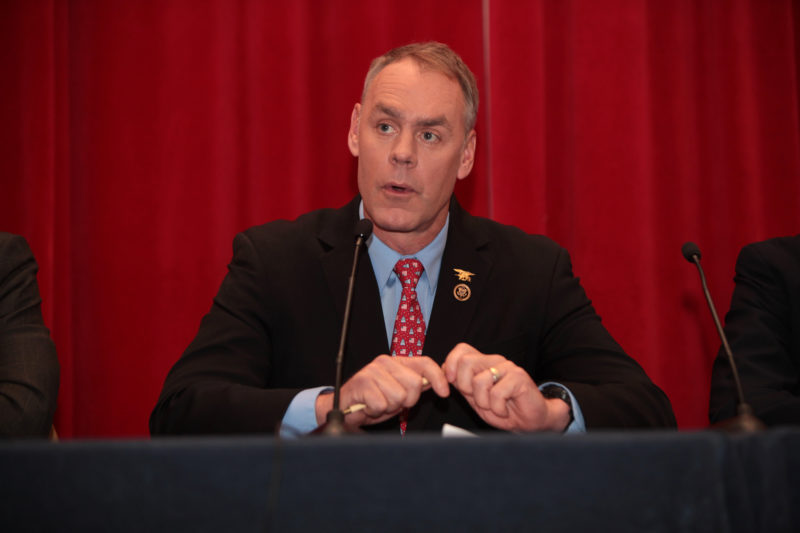More opportunities for commercial fishermen could be coming soon as the Trump administration considers making changes to three marine national monuments.
That’s among the recommendations Interior Secretary Ryan Zinke has made to President Trump, according to The Associated Press, which obtained a leaked copy of the report he submitted to Trump on August 24. In April, Trump ordered Zinke to conduct a review of the country’s national, after claiming previous presidents abused their powers by blocking vast amounts of land and sea from commercial interests through overly broad use of the Antiquities Act.
The report comes just days after the one-year anniversary of President Barack Obama’s order creating the Northeast Canyons and Seamounts Marine National Monument, the first such monument in the Atlantic Ocean. The monument is just more than 4,900 square miles in total size and is located about 100 miles southeast of Cape Cod, Mass. Obama, as other presidents have had since 1906, used his authority under the Antiquities Act to make the designation.
According to the AP’s report, Zinke’s memo recommends keeping the monument at its current size, but he would rescind the ban on commercial fishing operations within it. Obama’s order prohibited all commercial fishing, except for a temporary allowance of red crab and American lobster fishing, which received a seven-year exemption.
“There seems to be a huge misconception that there are limitless areas where displaced fishermen can go,” said Grant Moore, president of the Atlantic Offshore Lobstermen’s Association. “Basically with the stroke of a pen, President Obama put fishermen and their crews out of work and harmed all the shore-side businesses that support the fishing industry.”
Just as Obama’s actions drew praise from conservation advocates and scorn from seafood industry groups, news of Zinke’s recommendations is having the opposite effect. While the White House has yet to confirm the details of the memo, seafood trade organizations and industry leaders are reading Zinke’s report as a good sign.
“(T)he reported recommendations from the Interior Department make us hopeful that we can recover the areas we have fished sustainably for decades,” said Eric Reid, general manager of Seafreeze Shoreside in Narragansett, Rhode Island. “We are grateful that the voices of fishermen and shore side businesses have finally been heard.”
Lora Snyder, campaign director for environmental nonprofit Oceana, said the national monument designation is meant for America’s special places. To her, the deep underwater canyons and mountains are worthy of federal protection.
“This short-sighted recommendation to allow commercial fishing in the New England Coral Canyons and Seamounts Monument ignores vast public input and will expose this special area to threats forever,” she said, adding that she hoped Trump will reject that recommendation.
Whatever decision Trump ends up making about the Northeast Canyons, the monument’s fate will likely eventually be decided in the court system. Earlier this year, a group of seafood trade organizations filed a lawsuit against the federal government in an attempt to block the monument designation.

New Bedford, Mass. Mayor Jon Mitchell. City of New Bedford photo.
“The fisheries management process under the existing Magnuson Act is far from perfect, but its great strength is that it has afforded ample opportunities for all stakeholders to study and comment on policy decisions, and for peer review of the scientific basis for those decisions,” wrote Mayor Jon Mitchell of New Bedford, Massachusetts, the nation’s top-grossing commercial fishing port.
In March, Mayor Mitchell submitted testimony to Congress expressing concern over marine monuments. “The marine monument designation process may have been well intended, but it has simply lacked a comparable level of industry input, scientific rigor, and deliberation. That is why I think hitting the reset button ought to be welcomed no matter where one stands in the current fisheries debates, because the end result will be better policy and better outcomes,” he wrote.
In addition to the Northeast Canyons and Seamounts, Zinke has looked at making changes to two additional marine national monuments – the Pacific Remote Islands and Rose Atoll monuments. Zinke has recommended reducing the size of both monuments and allowing the resumption of commercial fishing there, the AP reported.
Just as conservationists have threatened legal action against removing protections from the Northeast Canyons, they’re also willing to put up a similar fight to protect the Pacific monuments as well.
“The law is clear: only Congress has the authority to change a national monument designation under the Antiquities Act, not the president,” said Drew Caputo, Earthjustice’s vice president of litigation for lands, wildlife, and oceans. “If President Trump attempts to carry out any recommendations to gut or shrink our national monuments, we will see him in court.”
However, Zinke in the executive summary of his report to the president – the only portion of his report that has been made public – noted that previous presidents have modified existing national monuments. That includes reducing their size, he said.
In his 120-day review, as requested by President Trump, Zinke looked at the 26 designations of monuments greater than 100,000 acres in size made by presidents since 1996. He visited eight monuments, including Northeast Canyons, and also met with key stakeholders. It was during those visits that he said he heard from locals regarding the economic hardships brought forward by the monument designations.
“No president should use the authority under the act to restrict public access, prevent hunting and fishing, burden private land, or eliminate traditional land uses, unless such action is needed to protect the object,” Zinke said in his summary.
This story was originally published on SeafoodSource.com and is republished here with permission.







